Tamaskan Dog Breed Temperament Training And Diet
Do you fancy a wolf-like sled dog that will accompany you for life? You’ll want to meet the Tamaskan Dog.
This wolfish crossbreed has stolen the hearts of sled-lovers and pet owners worldwide. We introduce you to this fellow’s quirks and how to take care of it.
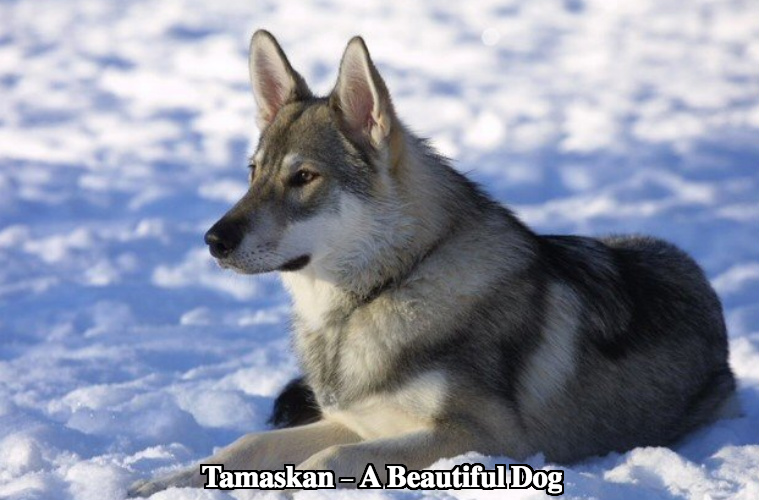
1. What is a Tamaskan Dog?
The Tamaskan is a crossbreed that hails from the reindeer-populated slopes of Finland. It is a hybrid of many sled dogs that include the Alaskan Malamute, the Czechoslovakian Wolfdog, and the large, gentle Siberian Husky. The American Rare Breed Association has recognized it as a breed. Highly versatile, it performs well in obedience, agility and working dog trials.
2. Tamaskan Dog Origins and Stories
a. The Tamaskan Dog
The Temaskan dog came to be because of a breeding attempt in the 1980s. Breeders brought in five Siberian Husky-like dogs from the United Kingdom. They bred these dogs with the Siberian Husky, Alaskan Malamute, German Shepherd and the Czechoslovakian Wolfdog to form the Tamaskan Dog.
The Tamaskan has not received recognition from official kennel clubs like the American Kennel Club. However, there are small breed clubs like the Tamaskan Dog Register, the National Tamaskan Club of Canada, the Netherlands Tamaskan Club, and the Tamaskan Dog Society of Great Britain. We do not have much documentation of its origins, but we do know a lot about its parents.
b. Alaskan Malamute
The Alaskan Malamute had a prominent role as a working dog which hunted with humans. They were famous for their hunting abilities and sought out large prey, like bears. They also pointed out seal blow holes for their arctic owners.
They became particularly valuable to the prospectors and settlers during the Klondike Gold Rush of 1896. These enthusiasts bred the dogs with other breeds to enhance their qualities.
Mrs. Eva B Seeley was responsible for getting the Alaskan Malamute recognized. She only used pure reds for breeding. The American Kennel Club recognized it in 1935. The rigors of war in the 1940s eliminated the breed, but the AKC reopened its stud book in 1947 when 30 dogs remained.
A breeder named Robert J Zoller bred his twin dogs, M Loot and Hinman, with Kotzebues to create Husky Paks. Modern Malamutes descend from these dogs and have their characteristics.
The Alaskan Malamute has an exciting history. It accompanied Rear Admiral Richard Byrd to the Soth Pole and worked with miners as search and rescue dogs. It pulled freight, raced, and hauled supplies to camps. The Alaskan Malamute became the official state dog of Alaska in 2010.
c. Czechoslovakian Wolfdog
The Czechoslovakian Wolfdog came to be in 1955 when breeder Karel Hartl pondered crossing a Carpathian wolf with a German Shepherd. The breeding began as a military experiment, but she soon went on to establish a new breed. The first Czechoslovakian Wolfdogs were the offspring of a male German Shepherd named Cezar and a female wolf, Brita.
Their puppies were similar to wolves in temperament and appearance. They were difficult to train, so Karel decided to reduce the ‘wolf’ in the next batch of puppies. The third and fourth batches of pups she produced had better navigational skills, sense of smell, and night vision than their predecessors. They also tired less quickly.
Her efforts gained recognition at the annual meeting of the Federation Cynologique Internationale (FCI) when she gave a lecture about crossing dogs with wolves.
Karel created a draft standard for a new dog breed. The mating of wolf Brita and German Shepherd Kurt formed the basis for the second generation of pups. They came to be when the wolf Argo mated with Asta, a female German Shepherd. Official kennel clubs refused to give these dogs recognition, so Karel moved most of them to Slovakian military kennels. These were the birthplaces of the first Czechoslovakian wolf litters.
In 1977, one of the third-generation hybrid females, Xela, mated with a wolf, Sarika. Sarika also mated with another hybrid, Urta, from the border guard division. The last addition of wolf genetics was in 1983 when wolf Lejdy of Ohrada Zoo mated with German Shepherd Bojar von Stottenhof. Breeders called their puppies Czechoslovakian Wolfdogs.
Frantisek Rosik presented the breed for official recognition again in 1982 through the club, Breeders of Czechoslovakian Wolfdogs, or the Slovakian Breed Club as it is known today. The Czechoslovakian Breeders finally acknowledged it. One of the dogs won the title of World Champion at the 1990 World Dog Show in Brno. It met the criteria of the FCI.
There were 168 females and 170 males in 2012. Italy currently breeds the most number of puppies. The breed is now widespread in the United Kingdom, Czech Republic, and Slovakia.
d. The German Shepherd
A 2018 genetic study proved that the German Shepherd descends from European herding dogs. Other breeds that contribute to it are the Bergamasco Shepherd, Cane Patore, Lupino del Gigante, and the Pastore d’Oropa.
The German Shepherd was the most common herding dog in Northwest Europe in the 1800s. Farmers used it to protect their livestock, and it earned the title Continental Shepherd Dog. The Belgian shepherd, Dutch Shepherd, and the German Shepherd had strikingly similar outlooks.
Artists captured the German Shepherd in their works from 1909. Breeders attempted to standardize Shepherd dogs in the 1850s. They tried to accentuate the traits that helped them in their jobs as herding dogs. Hence, German Shepherds are protective, agile, and watchful. They were smart, fast, stable, and had keen senses of smell. However, there were differences between them, depending on their locality.
The society disbanded because of conflicts between members who wished to breed the dogs for their appearance and those who believed that they should produce dogs for work. It did not achieve its aim but inspired other breeders to standardize dog breeds.
With the rise of industrialized cities in Germany came the decline of the predator population. Sheepdogs became redundant. An ex-number of the Phylax Society, Max von Stephanitz, a graduate of the Berlin Veterinary College felt that dogs were meant to work. He realized how versatile, intelligent, and hefty they were and wanted the ideal working dog.
Von Stephanitz encountered a handsome working dog named Hecktor Linkshein in 1899. It was the product of selective breeding and fulfilled all his expectations of working dogs.
He was so satisfied with the dog’s strength, loyalty, and intelligence that he bought it without hesitation. He changed the dog’s name to Horand Von Grafrath and founded the Verein fur Deutsche Schaferhunde (Society for the German Shepherd Dog). Horand became the society’s first registered dog.
Horand was the progenitor of the German Shepherd breed. Von Stephanitz bred him with members’ dogs that had suitable traits as well as dogs from Thuringia, Wuttermberg, and Franconia.
Horand’s most successful offspring was Hektor von Schwaben. It bred with Horand’s other pups and sired Heinz von Starkenberf, Pilot, and Beowulf. Pilot fathered eighty-four pups in total, and these bred with Hektor’s other puppies. The club believed that the inbreeding would preserve the traits that Von Stephanitz wanted in working dogs.
There are four wolf crosses in the original German Shepherd studbook. They drew a genetic link from Beowulf’s inbred offspring. Von Stephanitz uncompromising stand on breeding enabled him to create a dog with perfect working abilities.
People knew it as the Deutscher Schaferhund, literally translated as the ‘German Shepherd Dog.’ It became the ideal assistant for shepherds, who called it the Altdeutche Schaferhunde, or Old German Shepherd Dog. The official breed registry adopted the direct translation.
The UK Kennel Club renamed it the Alsatian Wolf Dog during the Second World War, owing to anti-German sentiment. It derived the name from the French region of Alsace, which bordered Germany. Other international clubs took on the title. They also dropped the term ‘wolfdog’ because of legal issues. They used ‘Alsatian’ for about 50 years.
Enthusiasts pressured UK Kennel Clubs to re-register it with the name German Shepherd. The name Alsatian remained until 2010 when they removed it.
e. Famous Tamaskan Dogs
Genghis Khan, a prizewinning Tamaskan Dog, took on the role of a wolf in a music video for the musical group, Lucretia Choir in October 2007.
Wave, a male Tamaskan, became the mascot of the Carolina State University football team in 2010. It now attends all its home games and is always on the sidelines.
The Croatian television program, Kuchni, featured four Tamaskans in September 2012.
Adler, a Tamaskan, featured in news outlets like the Daily Mail, Boston Times, and the Bark Post because it played Tug-of-War by using its mass.
Luchta, a Tamaskan, appeared on Broadway in 2016. It was the wolf in a production of Arthur Miller’s The Crucible, directed by Ivo Van Hove.
Kaoru, a Tamaskan therapy dog, helped many children with Autism. However, a hunter mistook it for a wolf and shot it at close range. The incident resulted in the dog’s death.
3. Tamaskan Dog Appearance
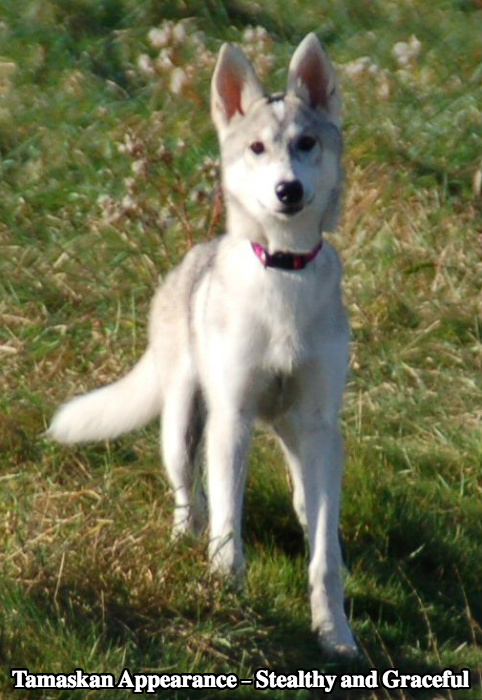
The Tamaskan Dog is one of the most wolf-like dogs today. It embodies its wolf lineage with charm and grace.
a. Height and size
Standing at 33 inches and weighing about 100 pounds, this dog is almost as large as a Gray Wolf. True to its heritage, it has an even topline and a short, falling croup. It has a muscular, tucked-in belly.
b. Head, muzzle, and nose
The Tamaskan Dog’s head is long and narrow. It comes to a stop just before its pointed muzzle. Its nose is black.
c. Eyes
The Tamaskan Dog’s eyes are one of many colors. They are most probably black or brown, though hazel and amber eyes aren’t unknown.
d. Ears
This wolf-like creature has pointed triangular-shaped ears. They contain tiny, feathery hairs that you must pull out regularly.
e. Coat
A Tamaskan Dog has a thick, dense double coat. Hair colors are white, gray, black, amber, or a combination of these. The thick hairs make regular brushing necessary.
f. Tail
This wolf-like dog has an attractive, bushy tail that hangs when it is resting and stands erect when it is at play.
4. Tamaskan Dog Grooming
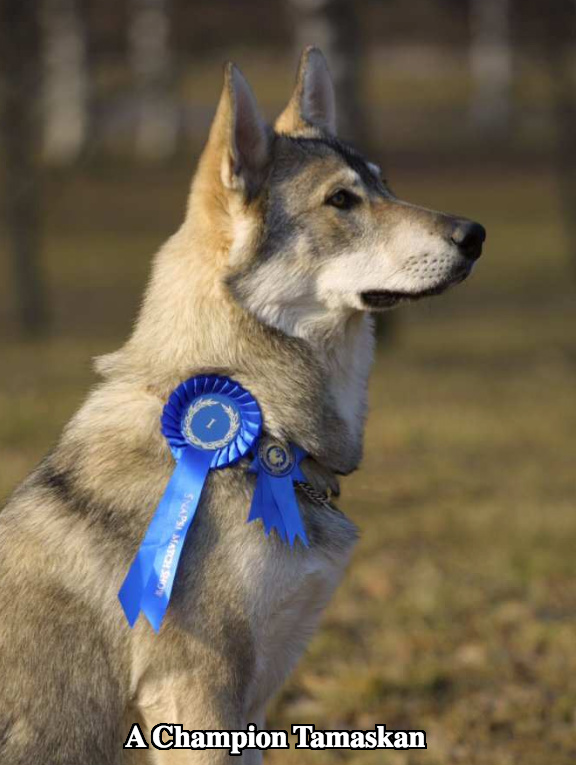
Grooming can feel like a tremendous undertaking. Tamaskan Dogs may have short hair, but they do need care.
Step 1: How to calm a Tamaskan Dog before grooming
Dogs, including wolf-like dogs, get edgy before a grooming session. Walk your pet beforehand. Walking is an excellent way for it to burn off energy and will make it more amenable to grooming.
Touch your dog gently. Rub its ears, belly, and paws every day until it no longer flinches.
Give your pet a daily massage. You should be able to touch your pet for long periods of time. When your pet is no longer anxious about being handled, introduce it to the slicker brush. Let your pet sniff it and get used to it.
Step 2. Coat care
Both layers of a Tamaskan Dog’s coat require care. The thick coats add to this wolf hound’s regal bearing. They also keep the dog warm in freezing temperatures.
Note that double-coats need more maintenance than smooth ones. They shed at least annually. The shedding process helps the dog to cope with extreme temperatures. Strip the coat either by hand or with a stripping knife.
When stripping, start at the back of the neck and work in the direction of the hair growth. Pull the hairs out gently; they should come off quickly. The neck should look clean after you’ve finished. The shoulder blades should look flat.
Strip and brush the belly till the underline shows. The thighs should look rugged, so strip them to give them a clean look.
Step 3: Brushing your Tamaskan Dog
The good news is that the Tamaskan isn’t that difficult to groom. Maintain its coat with regular, weekly brushing.
Use a wide-toothed comb to remove the dog’s mats, followed by a paddle brush to manage stray hairs.
Brush the undercoat first. Do so away from the skin, making sure to remove loose hairs. Move to the overcoat and brush in the direction the hair is growing.
Step 4: Bathing
Your Tamaskan Dog wouldn’t need to bathe too often if it lives in a cold climate or has a sedentary lifestyle. Do so more frequently if it’s active.
Use a dog shampoo because the Ph level will be suitable for your Tamaskan Dog. It should be for harsh coats as its hairs are coarse.
Step 5: Nails
You should keep your wolfhound’s nails short, especially if you have wood floors that are susceptible to scratching. If you can hear your pet’s nails clicking on the floor, they are too long.
If you are cutting your dog’s nails for the first time, rub its paws gently. Don’t cut into the quick as this will cause profuse bleeding. Cut a little of the dog’s nail at a time. Use nail pliers or guillotine cutters.
Step 6: Teeth
Brush your dog’s teeth daily with toothpaste for dogs. Don’t use toothpaste for humans as dogs are allergic to fluoride.
Start by putting a little toothpaste on your finger and rubbing your pet’s teeth with it. Graduate to a toothbrush when it’s comfortable.
5. House training your Tamaskan Dog
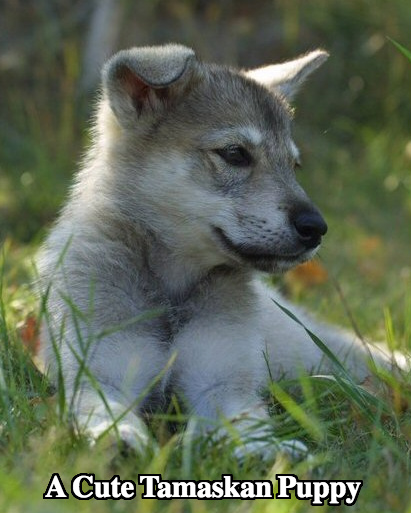
Potty training a Tamaskan Dog or any other is a task that takes effort and patience. We share a few tips to ease the process.
a. Use Crates As a Potty Training Tool
Many pet owners cringe at the idea of crates. However, the latter are useful tools, particularly on road trips or when it’s necessary to keep a pet safe. They are essential potty training aids.
Does your pet have a specific spot in the home where it likes to curl up and sleep? Dogs are den animals and crave security. It is easy to get your Tamaskan Dog to love its crate.
You may ask how a crate helps with the house training process. Dogs are naturally clean creatures which don’t like to sleep in unsanitary conditions. Since it is a
sleeping area, your Tamaskan Dog will not want to get it dirty. Make sure that it’s of a suitable size. Your pet will use an area of it to eliminate if it is too big. Your dog should be able to sit, lie down, and turn around in the crate. There are some crates that you can adjust as your puppy grows.
If your puppy feels the urge to relieve itself, it will let you know by moving about agitatedly, whining, or scratching. Don’t delay taking it out of the crate because it will think that it’s alright to dirty its space.
b. Puppy pads or newspaper
Using these can be tricky because you are giving your puppy two different elimination options. If the situation is ideal, the dog will hold it indoors and ease
itself in specific areas outdoors. After all, the Tamaskan Dog is large.
However, lifestyle constraints, such as apartment living, may force you to use newspapers or puppy pads. Once the puppy knows where to relieve itself, you can begin outdoor training. Your pet will also understand where it can eliminate indoors.
Begin by putting your pet in the approved ‘ toilet.’ Lay the area with newspaper or the puppy pad. You can remove the paper gradually as your pet comes to understand that it can relieve itself there.
c. Schedules
Schedules are essential for housetraining success. Puppies have small bladders and digestive systems, so they will need to eliminate a few times daily.
Puppies can usually control their bladders to their corresponding age numbers. For example, a four-month-old puppy should be able to hold it for about 4 hours. The time of day is another useful guide. Puppies need to ease themselves when they wake up, after they eat, and before they go to bed.
You may find yourself running to make sure that the newest member of your family eases itself in the right places. The faster you teach it where are the approved areas are, the easier your job will be.
d. Observation and Supervision
Watch your pet to learn its signals. While some dogs can hold it for a long time, others may need to go every time they play. Dog potty habits are idiosyncratic.
e. Diet
Puppies cannot eat a lot of food at once because their digestive systems are fragile. Break the feedings into small meals. Furthermore, make sure that the food you choose agrees with your pet.
Examine your pet’s stool to find out if it’s time to change its diet. If it is bulky, runny, or particularly smelly, it’s the right time. Also, remember not to overfeed your pet as this may cause diarrhea and make house training difficult.
f. Praise
Use positive reinforcement instead of threatening your pet. Never hit or scold it for easing itself in the wrong places, as this will only cause it to run away from you.
g. Clean messes immediately
Remove ‘accidents’ at once with an enzymatic cleaner. The scent will not remain.
6. Feeding Your Tamaskan Dog
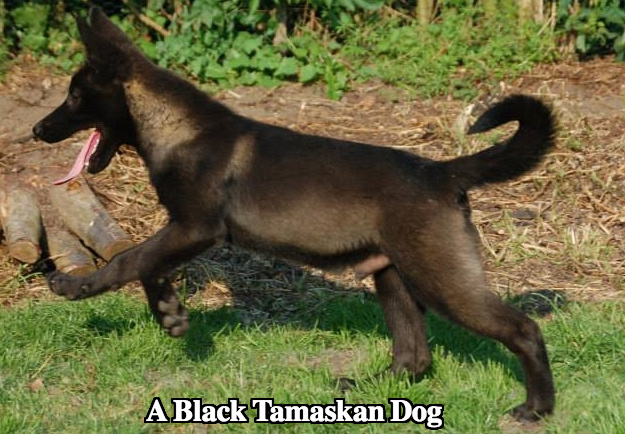
Every new dog owner asks him or herself: “What should I feed my pet?” Here are some diet options you may want to consider.
a. Debunking the myth
Many pet owners believe that their dogs shouldn’t eat raw meat as it makes them vicious. However, this is a myth that needs debunking.
Tamaskan Dogs need meat in their diet. Forcing your pet to abstain from it may cause malnutrition. Furthermore, remember that this dog needs more than just meat.
b. The Raw Food Diet
This diet consists of letting your Tamaskan Dog feed off raw meat. While a little controversial, it fulfills the Tamaskan’s nutritional requirements. It is convenient and requires little preparation.
That said, don’t feed your pet raw meat if it has a sensitive stomach. Make sure that you clean uncooked food thoroughly before giving it to your dog; you won’t want it to ingest parasites.
c. The B.A.R.F. Diet
The Bones and Raw Foods Diet (B.A.R.F. Diet) is similar to the Raw Food Diet, except that it includes fruits and vegetables safe for dogs. Wolfdog mixes like the Tamaskan Dog enjoy carrots, celery, watermelon, and peaches.
Exercise your creativity when giving your pet treats. You can put them in Ice cube molds, hang them on a tree branch in your garden, or hide them in the secret corners of your living room. They will keep your Tamaskan Dog occupied the entire day.
Take advantage of your garden. You can hide vegetables around your yard. Tamaskan dogs and other wolf-like canines love the taste of pumpkin. It is amusing to watch it crunching on a cabbage. Don’t feed raisins, avocados, or onions. Most dogs are allergic to them.
Whole chicken, beef, and venison are excellent choices when feeding meat to your pet. You may choose to feed it ground meat; you can find it a bargain in most supermarkets. Avoid feeding your Tamaskan Dog pork as it is full of growth hormones.
Be careful when giving your Tamaskan Dog bones. Beef bones are typically femurs that are hard and can shatter teeth. Chicken bones are sharp and can splinter.
d. The Home-Cooked Diet
The Home-cooked Diet is true to its name. It refers to food prepared in your kitchen. These include whole meats, grains, and vegetables. It is suitable for pet owners who feel morally conflicted about giving their dogs raw meat.
There are disadvantages to cooking; it removes healthy bacteria and nutrients. Cooked food may not suit your Tamaskan Dog if it has dominant wolf genes. Your pet may suffer from stomach aches and diarrhea.
e. The Kibble Diet
Although accessible, the kibble diet is not complete. It doesn’t offer all the nutrients a Tamaskan Dog needs to be healthy.
Furthermore, your pet may not be able to withstand it if it has a sensitive stomach. A mixed diet of kibble and raw meat may suffice its needs, but as mentioned before, do observe its stool.
f. Feeding potions
If your Tamaskan puppy has dominant wolf genes, read it high-quality puppy food and small pieces of raw meat a few times a day until it is eight weeks of age. After this, reduce this number to thrice daily feedings.
When your pet is about five months old, it should be eating twice a day. You can offer your adult Tamaskan Dog twice-daily meals or break these into small portions. It should be eating five to seven pounds of meat a day.
g. Treats
Provide healthy treats like grain-free biscuits. Experimenting with different flavors will allow you to find out what your pet loves. Feed them in moderation.
h. Water
Your pet should have free access to cold water. You can add fresh fruit juice to the water if it doesn’t like to drink. Make sure that it isn’t grape juice as dogs are allergic to grapeseed.
7. Tamaskan Dog Temperament
A burning question in every owner’s mind is whether a Tamaskan Dog makes a suitable pet. To answer it, we take a look at its personality or ’dogsanality.’
The Tamaskan Dog is known to be agile, obedient, and intelligent. Like its Arctic cousins, it makes an excellent sled dog.
The Tamaskan Dog serves as a search and rescue dog, owing to its intelligence. It’s responsive, sociable, and has a relaxed demeanor.
8. Quirky behaviors of Tamaskans
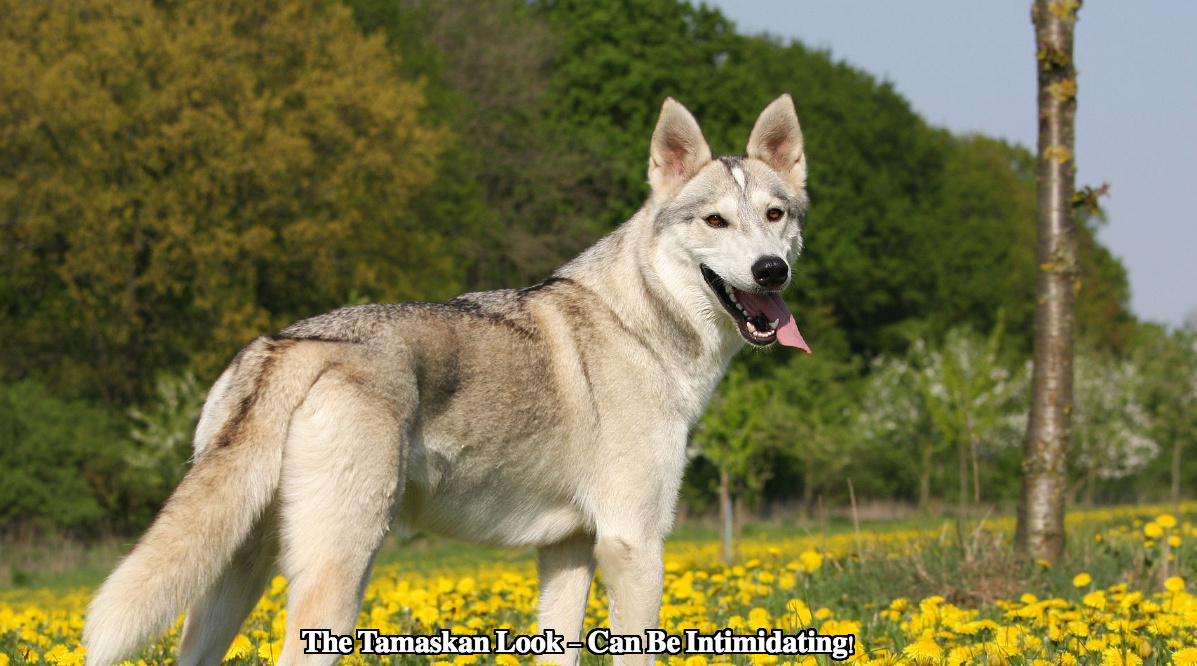
No human is perfect, and no dog is either. Your Tamaskan Dog may have bad habits like all other canines. Here are a few, and how to manage them.
a. Barking/ Howling
True to its wolf bloodline, your Tamaskan Dog may bark or howl. Both need management.
Teach it the command ’no speak.’ Hold its muzzle while giving the instruction. Remember that some barking is healthy – you do want your dog to tell you when someone is at the door.
b. Chasing
Your Tamaskan Dog may have a propensity to chase moving objects. Of course, this is a habit you want to break quickly.
Begin your training indoors. Your dog should be leashed and taught the ‘come’ command. Pull on it when your pet starts to get restless.
Move the training outdoors once it understands that the command is a signal to return. Repeat the procedure until your pet returns on its own.
c. Chewing
Is your Tamaskan Dog too fond of your favorite slippers? You need to teach it to stop chewing.
When you catch your pet with a foreign object in its mouth, replace it with a chew toy. Use the word ’no’ when it displays this behavior.
d. Digging
A Tamaskan Dog should not be alone for too long, as it will become destructive, It may start to create holes in your garden.
If your dog does this, put a sandbox in your yard. This area will become it’s digging space.
e. Begging
Dogs love to hang around our dinner tables because our food tastes better than theirs. But we must resist the urge to give in to the doe-eyed look.
Ignore your pet when it begs. Even saying ’No’ tells it that it has your attention and will eventually get what it wants. You can feed it at your mealtimes; this will keep it from being distracted by the food on your table.
f. Nipping
Dogs love to nip at their owners’ heels as a sign that they want to play. Loving as the behavior is, it is unacceptable.
To get your pet to stop the habit, let out a loud yelp. It will feel concerned that it has hurt you and refrain from nipping.
g. Separation Anxiety
Some pets feel insecure without their owners. The sullen behavior can lead to destructive tendencies, and this is particularly true of wolf dogs.
Leave your home for short periods at a time. Say goodbye to your pet but don’t make a fuss. As your dog becomes used to you being away, extend the time you spend away from home. Play soft music for it while it waits.
h. Aggression
Does your Tamaskan Dog growl around people and their pets? If so, you need to deal with its aggression.
The key to getting your dog to stay friendly and well-mannered around others is socialization. Make sure that you bring it on daily walks or to dog runs. Stay away from potential conflicts.
i. Gulping
True to its nature, your Tamaskan Dog may wolf down its food. It probably got used to doing this because it had to fight its littermates for its mother’s milk. Use bowls specially designed to stop pets from gulping.
9. Breeding Tamaskan Dogs
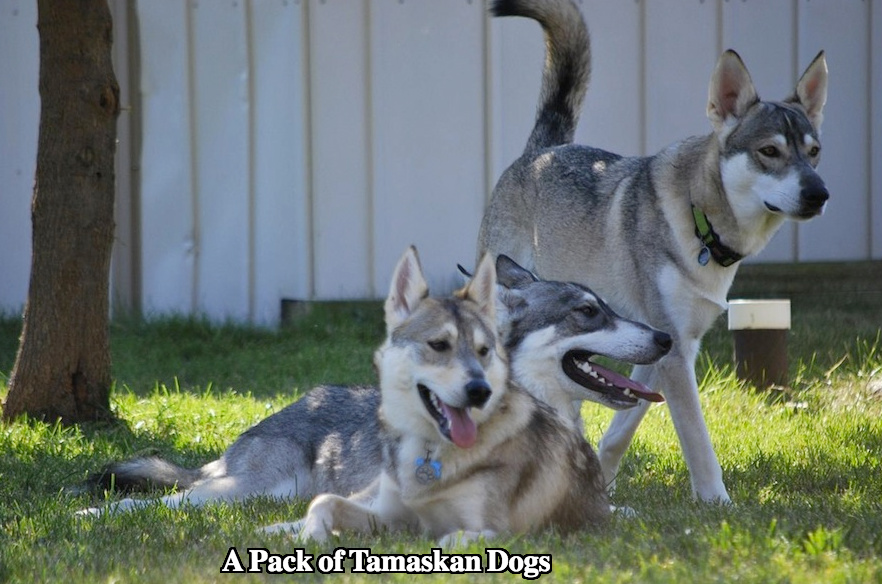
Breeding husky-like dogs like the Tamaskan Dog is challenging but rewarding. We take you through the process.
a. Choose suitable Tamaskan Dogs to breed
The Tamaskan Dog is relatively large, so it will take some time to mature. Your female Tamaskan Dog won’t be ready to breed until it is about two years old. It may experience its first heat cycle at about seven months, but won’t be prepared then.
Make sure that it has an even temperament, as an aggressive female will produce fiery puppies. Both the stud and dam should have registration papers.
Meet with them both and check for any health issues. Get your veterinarian to give them physicals and ascertain if they are ready to breed.
b. The mating process
Watch out for the proestrus, or your dog’s first period of its heat cycle. It will bleed, but will not be ready to mate. It can do so during the estrus or the second period of its heat cycle, which lasts for about nine days.
Bring the dogs together to mate during this time, as the female will be fertile. Let them mate twice or thrice. Keep the dam away from other males, or it will become pregnant with their puppies.
Take her to the vet once she starts showing signs of pregnancy. You may be able to spot them about three weeks after mating.
c. Caring for Your Pregnant Tamaskan Female
Feed your Tamaskan Dog a regular diet for the first part of its pregnancy. Give her more food as the size of her body increases. Feed her about 35 to 50% more food than usual. She should eat three times daily, and have an additional protein source, such as eggs, liver, or milk.
Prepare a whelping box where she can care for her new brood. Choose one that has low sides. Make sure that the whelping area is spacious and sanitary.
The puppies should arrive 63 days after pregnancy. Prepare for their arrival with:
- • Newspapers as bedding
- • Bath mats as bedding
- • Towels for cleaning the dam and puppies
- • Paper towels for cleaning the box
- • Thermometer for temperature checks
- • A heating pad
- • Dental floss
- • Scissors to cut the umbilical cord
- • Iodine for disinfecting the umbilical cord
Watch for the early signs of labor. Your female will start to create a nest for its pups. Its temperature will be about 99 degrees Fahrenheit and contractions will start. It will become restless and appear pained or confused. This stage typically lasts from between six to eighteen hours.
The second stage of the bitch’s labor takes place when its water breaks. Contractions will intensify, and puppies will appear every half an hour. Call the vet if you notice the mother trembling, shivering or if there is green discharge.
d. Caring for newborn Tamaskan Puppies
Let the newborn pups nurse straightaway, as they need colostrum from their mother’s milk. Weigh the puppies every two days to ensure that they gain weight. Keep the whelping box at a temperature of about 85 degrees Fahrenheit. You can reduce this by about five degrees over the next five days, and another five after about four weeks. Puppies need to eat every two hours.
10. Tamaskan Dog Health
Tamaskan Dogs are generally healthy but are prone to some disorders. Awareness and regular trips to your veterinarian will keep them at bay.
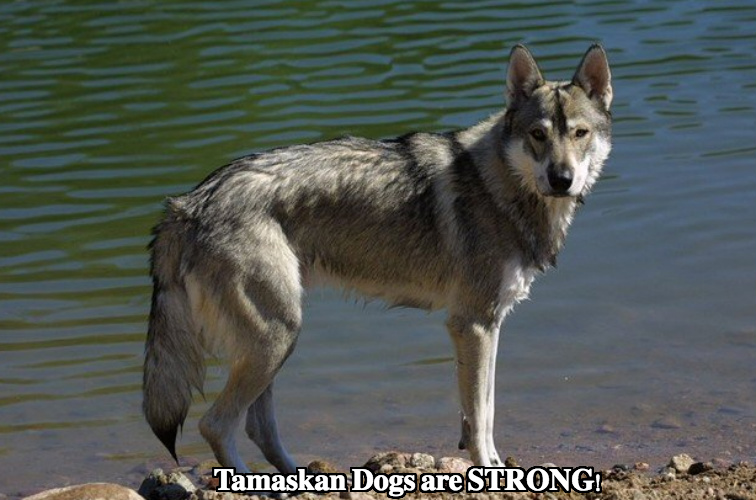
a. Hip Dysplasia
Hip Dysplasia refers to the dislocation of the hip joints and their failure to function normally. This disorder can be inherited but involves a complicated pattern of many genes. It is a common skeletal disease in dogs.
This disorder strikes when a dog is about four months of age when it is physically immature. Left unchecked, it can lead to osteoarthritis.
Symptoms include bunny hopping or a swaying gait. The joints produce a grating sound as well. An affected dog may show some reluctance to climb stairs and will find it hard to rise. Of course, there is an extreme pain in the hip joints.
b. Cryptorchidism
Cryptorchidism refers to a retained testicle. In most cases, it remains in the male dog’s abdomen because it typically descends from the abdominal wall. The dog’s testicle isn’t visible from the outside. It appears to be a hereditary condition.
The dog’s testicles fail to produce sperm. Also, it will experience severe abdominal pain. In some cases, the retained testicle may become cancerous. Vets will recommend immediate neutering.
c. Epilepsy
A chronic condition, epilepsy causes repeated seizures. In many cases, it is a lifelong disease.
The vet may diagnose epilepsy if your dog has seizures on more than two occasions. The dog will lose voluntary control and have random, quick neurological attacks. These appear to have a repetitive pattern.
There are several types of epileptic seizures. They may be focal, and the dog may experience episodic, uncontrolled twitches in a specific area of its body.
Seizures may also be generalized. The dog may experience muscle contraction and sporadic jerks on both sides of its body. They are often the symptoms of an underlying disease. A lack of sleep may cause them.
Idiopathic seizures happen in young dogs and are due to a combination of environmental and genetic factors.
Structural seizures may happen because of a lack of blood.
Stay calm if your pet experiences one. Move furniture out of its way and clear its airway. In most cases, antiepileptic therapy, or AED, usually controls them. It is essential to medicate your pet consistently.
d. Degenerative Myelopathy
This disorder may affect your Tamaskan Dog if it is a senior pet. Since it has some German Shepherd heritage, it may be prone to the disease.
The dog may experience loss of coordination and weakness of its hind legs. It will drag them and have difficulty climbing stairs.
At the intermediate stage, the dog will not be able to walk without support. It will also experience urinary incontinence. The dog’s legs will finally become paralyzed at the disease’s final stages.
This disease is hereditary. A dog is at risk if its SCO! Gene mutates, according to researchers. Unfortunately, there is no cure for this disease, but dogs can thrive with quality nursing care and mobility equipment like K9 carts.
11. Tamaskan obedience training
A well-trained Tamaskan Dog is a joy to own. Basic commands will ensure its independence and confidence.
a. Sit
This command is the first that every dog should know.
It keeps your pet in place when there are guests or in dangerous situations, e.g., at a pedestrian crossing.
To teach it, hold it over your dog’s nose. Move your hand upward. Your pet’s eyes will follow the treat. As they do so, its bottom will touch the ground. Once it is in this position, say ‘sit’ and give it the goodie.
b. Stay
This command will keep your pet in place when necessary.
It must first know how to sit. Get your pet into a sitting position. Hold up your hand and say ‘stay.’ Take a few steps back. Reward it with a treat if it stays.
Reward your pet even if it only stays for a while. Over time, increase the number of steps before giving it the treat.
c. Come
This command can keep a dog out of danger. It is useful if your pet accidentally rushes into oncoming traffic.
Leash your pet. Get down to its level and say ‘come’ while pulling on the leash. Reward it when it comes to you. Remove the lead when it has mastered the command and practice in an enclosed space.
d. Down
This command can be complicated for a dog to master because it involves submissive posture. Keep training relaxed, short, and fun.
Find a treat and hold it in an enclosed fist. Hold your hand up to its nose. Move your hand to the floor, then along the ground. Once it is laying flat on the floor, say down and give it the goodies.
e. Leave It
This command is useful when you want to stop your pet from nipping objects. Your pet will learn that it receives a reward for ignoring the item you want it to leave.
Hold a treat in both hands. Then. Show your dog the goodie in an enclosed fist. Say ‘leave it.” Your dog will try to get to it. Give it to him with the other hand when it stops sniffing the treat. Repeat this sequence until your pet can leave the first hand voluntarily.
12. Suitable activities for Tamaskan Dogs
All owners know that a bored pet is apt to become destructive. Here are a few games that you can play with your Tamaskan Dog.
a. Frisbee
This game differs from regular ball fetch because the disc stays longer in the air. Use a frisbee that’s easy to grip.
b. Water games
Get your Tamaskan Dog to play a game of fetch while someone sprays water from an outdoor hose. Why not take it to the beach and play in the shallow water on a hot day?
c. Predatory Chase
Tie a stuffed toy to the end of a retractable leash to invoke a chase response from your Tamaskan Dog. Touch the release button to stimulate movement. It will get your pet motivated. Your dog will be more enthusiastic with an animal scent.
d. Hide and Seek
Put treats or your pet’s favorite toys all over your home while someone holds it. When you are ready, call out to it. Say ‘ find.’ Watch your pet collect and eat all the treats.
e. Soccer
Your dog can catch a moving soccer ball or pick it up using its mouth.
f. Chase
Act like a canine partner and bow, inviting your pet to play. Jump back as it arrives. Do this in the other direction. Reward it with a treat when it catches up with you.
In conclusion, the Tamaskan Dog will make a responsive, loyal pet if you care for it well. Proper nutrition, housetraining, obedience training, and games will prepare it to be part of your family.